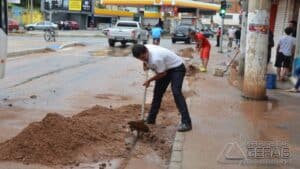The cities of Zona da Mata feel the economic impacts of the heavy rains that have hit the State of Minas Gerais in recent days.
Although the poor conditions of the roads have jeopardized the receipt of inputs and the flow of production from rural properties, which still face losses in plantations due to the large volume of water.
As the supply reduction has already triggered a price increase of up to 40% in fruit and vegetables. Another impact of the storms occurred in the industry, as among the most affected locations are municipalities that are part of the furniture hub of Ubá.

Financial loss
In trade, there are those who decided to close their doors temporarily, for reasons such as lack of demand or water invasion. The financial loss of both sectors has not yet been accounted for, but the representative entities confirm the seriousness of the situation and are mobilizing to help in the recovery of the affected places.
In the early hours of Wednesday (29), a crater opened at km 21 of the MG-133 highway, meanwhile Coronel Pacheco and Tabuleiro, after the asphalt gave way due to the rains.
accidents
This situation led to a serious accident in which a 37-year-old woman died and six other people were injured. Since then, the section has been closed. In this way, residents of cities belonging to the micro-regions of Ubá, Viçosa and Ponte Nova, who need to travel to Juiz de Fora. Although they should take the MG-353, on the route through Zona da Mata Piraúba, passing through Guarani, Rio Novo and Goianá to Coronel Pacheco, where they resume the normal route.
With no prediction of when the stretch of MG-133 will be recovered and with the aggravating factor that other areas were also affected by the rains, rural properties in the Zona da Mata had an impact on production.
"The Rural Area of Juiz de Fora is having difficulty in the disposal of products and the receipt of inputs", informed the president of the Rural Union, Domingos Frederico Netto. According to him, part of the products consumed by the judge-forans comes from cities in the region that were affected by the rains.
In the Guarani Rural Zone, the biggest concern is with milk production, estimated at 70,000 liters per day. The city, a forest zone that declared a state of emergency, had several side roads destroyed by the floods, which has jeopardized the flow of production.
“We are trying to minimize the impacts by working to clear these roads as quickly as possible, as milk is perishable. Production reaches R$ 100,000 per day, and this loss greatly harms our producers”, said Mayor Paulo Neves (PV).
Prices
This month, some products have already increased by up to 40% at the Minas Gerais Supply Center (Ceasa), such as tomatoes. “Some productions suffer a lot with the rainy season, such as leafy vegetables and fruit vegetables, such as zucchini, eggplant, cucumber and tomatoes, which are more sensitive to the weather.
This year we are facing an atypical January, with a very large volume of rain”, explained Ceasa's market information coordinator, Ricardo Fernandes Martins.
He also highlights the impacts of the rains on transport, which is also reflected in the increase in costs. “The situation is very complicated. Bad road conditions make it difficult to harvest and take products to market. We hope that the weather improves so that the situation is regularized.” According to Ricardo, in addition to tomatoes. There were high prices for chayote (20%), cauliflower (23%) and eggplant (15%).
The price comparison was made between the periods of January 16th to 19th and January 23rd to 26th and refers to the behavior of these foods in the state.
hortifruitigranjeiros
The effects are already perceived by the judge-forans. Owner of a fruit and vegetable store in the Municipal Market, Carlyle Francisco Lopes Barros routinely buys products at the local Ceasa unit. “Today, for you to buy, you have to arrive earlier and pay more”, he reports.
“The cities that produce the most merchandise for Juiz de Fora are Barbacena, Tocantins and Piau. So after the crater (on MG-133), the trucks have to travel many more kilometers, which also influences the price of the product.”
Therefore, the reflections reach the consumer's pocket. Products such as tomatoes, zucchini, chayote and eggplant are up to 40% more expensive. “Consumers who took two kilos of tomatoes now take one”, says Carlyle. “We try to get around the high prices by balancing the values of other products and negotiating with producers.”


